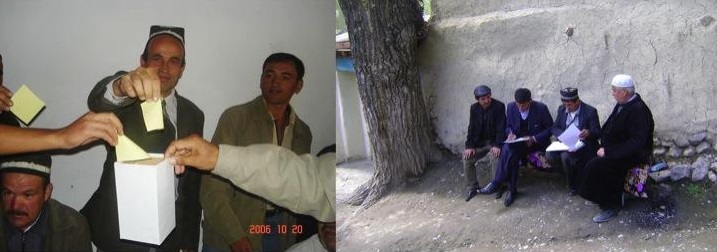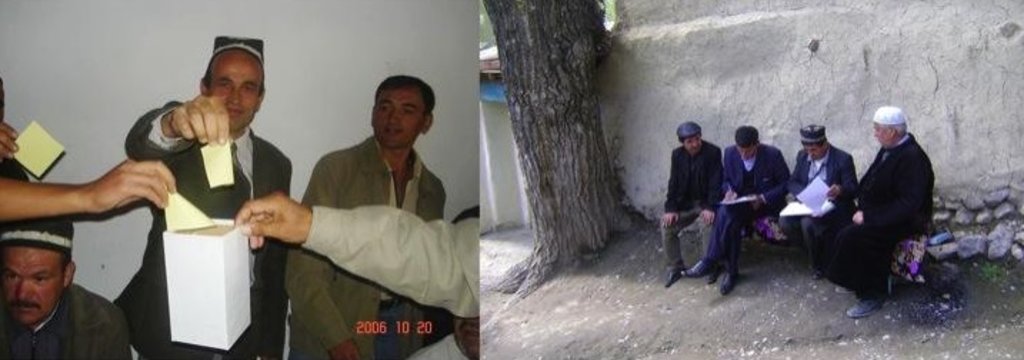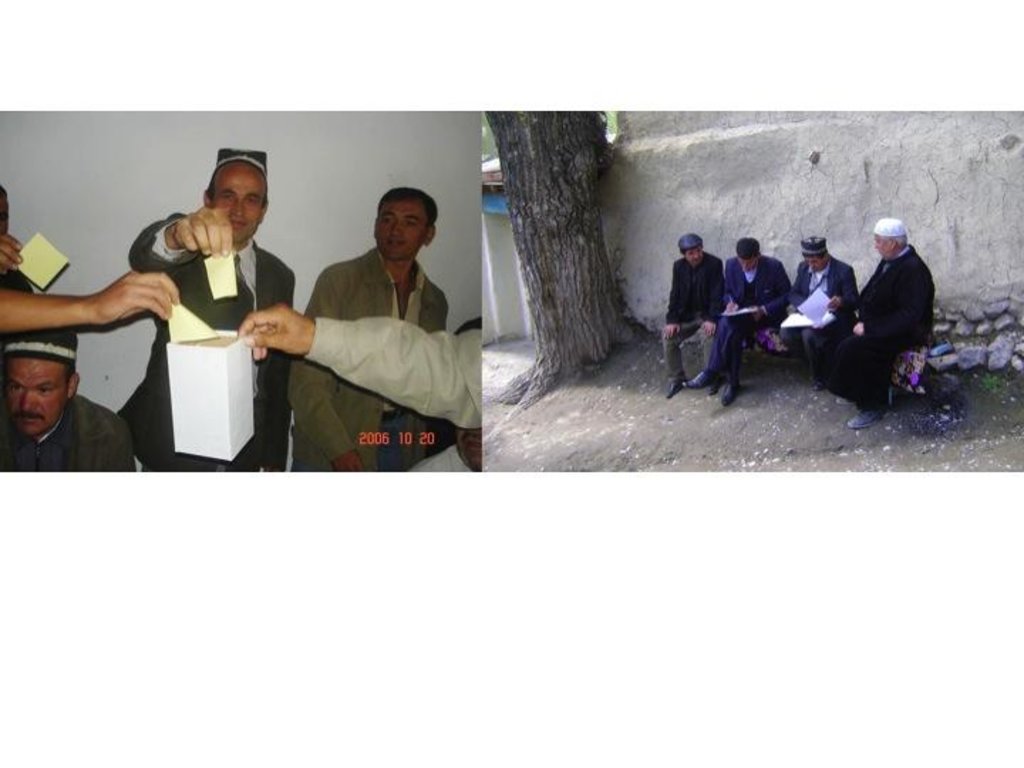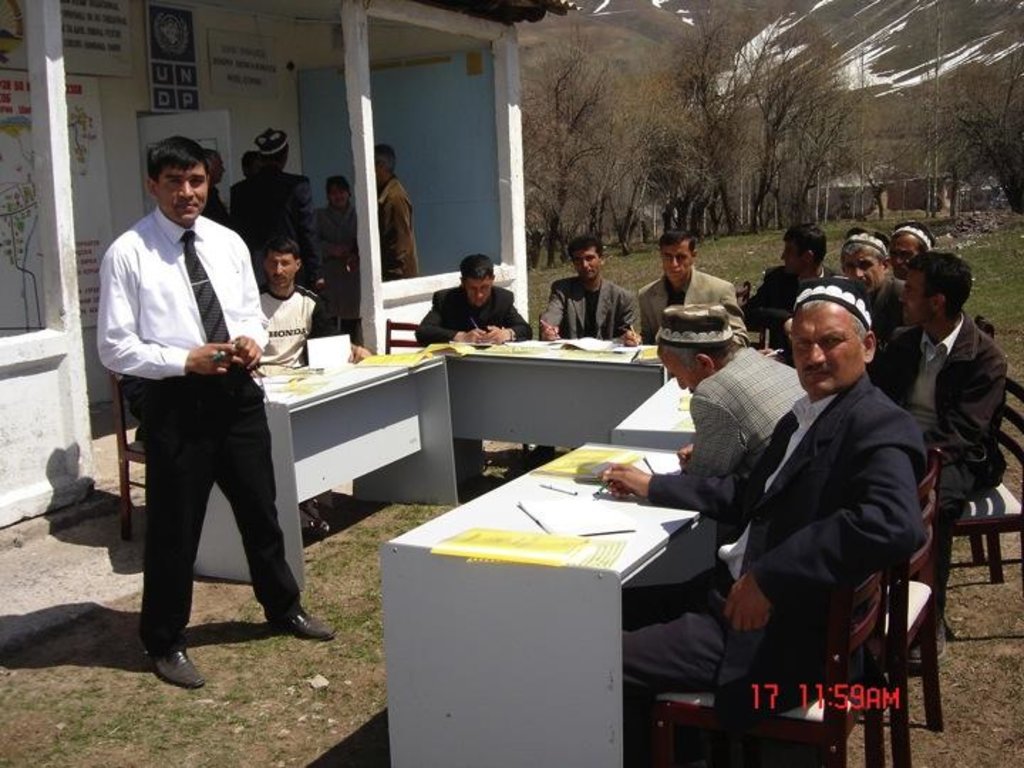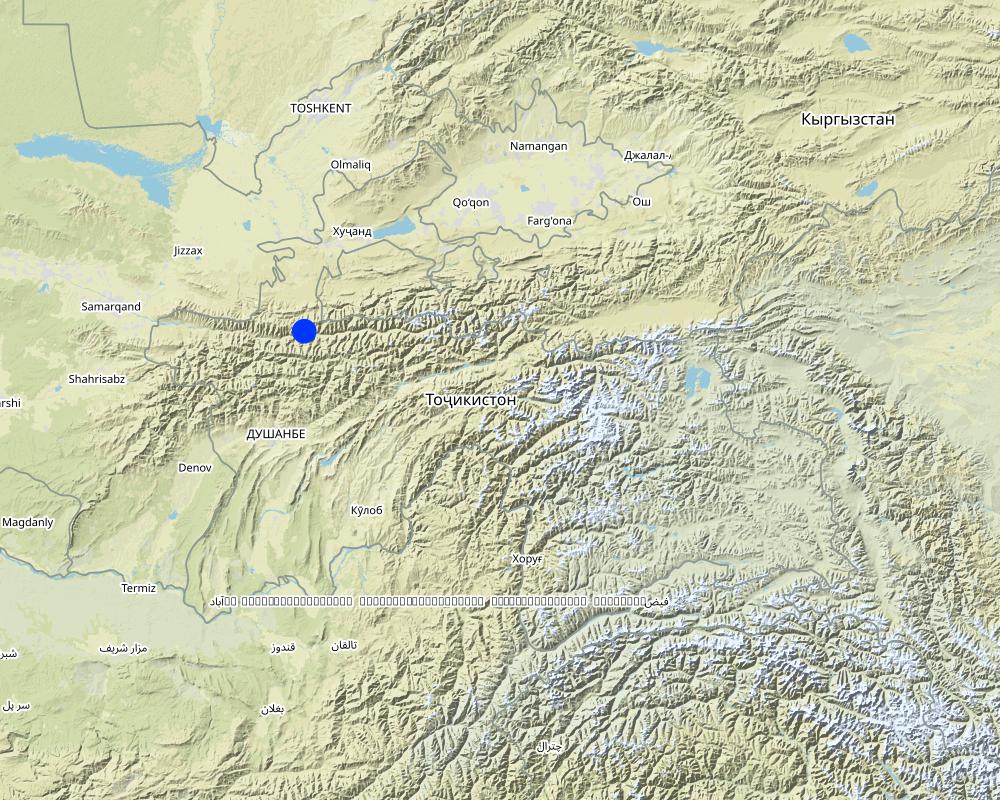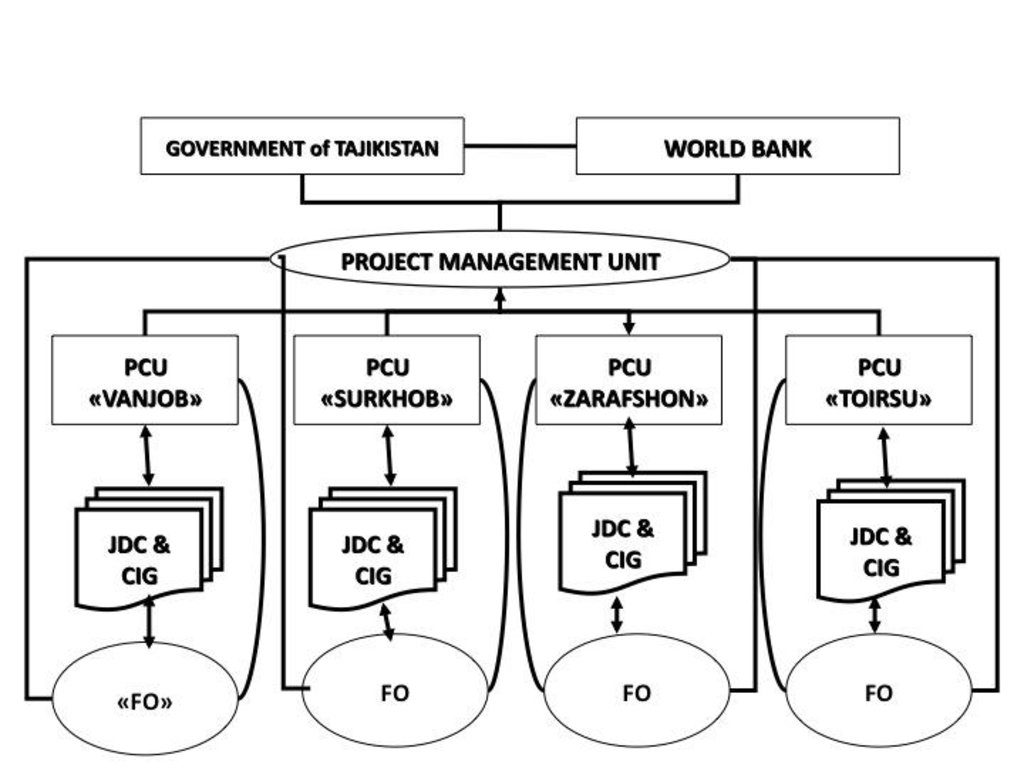Sub-district (Jamoat) level support for sustainable land management [Tajikistan]
- Creation:
- Update:
- Compiler: Nandita Jain
- Editor: –
- Reviewers: David Streiff, Alexandra Gavilano, Joana Eichenberger
approaches_2446 - Tajikistan
View sections
Expand all Collapse all1. General information
1.2 Contact details of resource persons and institutions involved in the assessment and documentation of the Approach
SLM specialist:
Mott Jessica
World Bank
United States
Name of project which facilitated the documentation/ evaluation of the Approach (if relevant)
Pilot Program for Climate Resilience, Tajikistan (WB / PPCR)Name of the institution(s) which facilitated the documentation/ evaluation of the Approach (if relevant)
World Bank (World Bank) - United States1.3 Conditions regarding the use of data documented through WOCAT
When were the data compiled (in the field)?
20/10/2006
The compiler and key resource person(s) accept the conditions regarding the use of data documented through WOCAT:
Yes
2. Description of the SLM Approach
2.1 Short description of the Approach
Provision of technical and financial management assistance through Jamoat (“Sub-District”) level organizations to farmers in a large small grants programme.
2.2 Detailed description of the Approach
Detailed description of the Approach:
Aims / objectives: The Tajikistan - Community Agriculture & Watershed Management Project (CAWMP), aimed to use a sub-district level organization to provide more efficient, transparent and accountable services to farmers for the project duration. CAWMP financed small grants to farmer groups for agricultural production in environmentally sustainable ways in Tajikistan’s uplands. The sub-district level support for this initial six year period, together with support from other project partners, helped (a) enable project implementation, and (b) build farmer capacity to sustain the investments after the end of six-year project, even in the absence of continued outside support.
Methods: In four project sites 39 Jamoat (“sub-district”) Development Committees (JDCs) operated as NGOs with elected officers and helped organize 43,000 households into groups to implement 4,000 rural production investments that included varied SLM technologies in 402 villages. JDCs managed $7.4 million in small grants. Use of the JDC built upon existing initiatives to strengthen local governance. The JDCs collaborated and received support from a government-appointed Project Management Unit (PMU), field-based Project Coordination Units (PCUs), and four contracted Facilitating Organizations (FOs). These partners helped train JDCs in financial, organizational, and technical aspects (e.g. fund flow, participatory planning, SLM technologies), and assisted villages to form new JDCs where none existed.
Stages of implementation: JDCs, with FOs and PCU specialists, undertook activities including: 1) preparation of participatory village-based Community Action Plans (CAPs) that included proposed rural production investments and formation of Common Interest Groups (CIGs) of households [See TAJ046}; 2) participation in sub-district and project-site/watershed level screening and approval of rural production proposals from CIGs to ensure economic, environmental and social feasibility [See TAJ045]; 3) management and disbursement of grant funds from the PMU to CIGs [See TAJ 044]; 4) overseeing formal investment agreements with participating CIGs; 5) monitoring, evaluation and reporting; and 6) liaison with other villages and relevant government agencies to facilitate permissions, resource use agreements, issuance of land use rights, etc.
Role of stakeholders: JDCs comprised elected village representatives and the government’s sub-district officials. Generally, JDC members have relatively higher levels of education and relevant knowledge and experience than the local population. A JDC chairperson and secretary were elected and a qualified accountant/bookkeeper appointed. JDCs met monthly and established committees, (e.g., gender, environment, financial management and social). CAWMP paid an honorarium for the accountant and incremental travel costs for all JDCs. For newly established JDCs, CAWMP also provided funds for office facilities, plus an honorarium for the chairperson, and an additional honorarium for another officer if one was female.
2.3 Photos of the Approach
2.5 Country/ region/ locations where the Approach has been applied
Country:
Tajikistan
Region/ State/ Province:
Sughd, Khatlon, RSS, GBAO
Further specification of location:
7 districts and 39 sub-districts
Comments:
As part of the Commnunity Agriculture and Watershed Management Project, the approach was implemented in Jirgital, Tajikibad, Vanj, Aini, Matcha, Penjikent, Danghara districts, in 4 regions. Four project sites/watersheds - Surkhob, Vanjob, Zarafshan and Toirsu - were included in the The total catchment area was 35,000km2. Total arable, farm and pasture land was approximately 319,500ha
Map
×2.6 Dates of initiation and termination of the Approach
Indicate year of initiation:
2005
Year of termination (if Approach is no longer applied):
2012
2.7 Type of Approach
- project/ programme based
2.8 Main aims/ objectives of the Approach
The Approach focused mainly on other activities than SLM (Sub-district assistance, non-government organizations, farmer groups, facilitation support, technical advice, fund transfers to farmer groups, )
Efficient and responsible sub-district institutional arrangements for a fixed-term project that are able to assist upland farmers in adopting practices to increase agricultural production in sustainable ways.
The SLM Approach addressed the following problems: Use of sub-district organizations provided an efficient, transparent and accountable way of providing essential services to farmers for the period of initial investment, i.e., the six-year period of project implementation. Alternatives ways of providing this support would have had disadvantages: such support at a village level would have been too expensive and faced human capacity constraints, while using the centralized government system or relying solely on large NGOs would have been less transparent, less participatory, and less accountable to the interests of local people.
2.9 Conditions enabling or hindering implementation of the Technology/ Technologies applied under the Approach
availability/ access to financial resources and services
- hindering
Poor transparency and accountability in financial transactions between government and farmers in rural development. Upland farmers lacked financial capital.
Treatment through the SLM Approach: JDC support services for managing about 4000 small grants, including participatory planning and streamlined fund transfers from PMU to farmer groups through JDCs.
institutional setting
- hindering
Limited financial and technical resources for upland agriculture given government focus on lowland crop, especially cotton, production. Remoteness restricts access to available services.
Treatment through the SLM Approach: Access to technical and financial services through establishment and capacity building of 39 JDCs in upland areas.
legal framework (land tenure, land and water use rights)
- hindering
Slow issuance of land use rights certificates for upland family farms - poor incentives to invest household assets and adopt SLM practices. No rights allocation for horticulture, woodlots and other uses with restricted access on sloping lands.
Treatment through the SLM Approach: Legal agreements governing CAWMP permitted issuance of certificates (including for sloping lands) to project participants on the basis of adopting SLM practices.
The existing land ownership, land use rights / water rights hindered a little the approach implementation Very few Land Use Rights Certificates had been issued at start of project for arable land in upland areas. There was no provision for allocation of use rights to non-arable sloping lands suitable for horticulture, woodlots and other restricted access uses.
knowledge about SLM, access to technical support
- hindering
Lack of technical capacity among farmers in participatory processes and SLM technologies and methods.
Treatment through the SLM Approach: Extensive training for JDCs in order to assist farmers. Trainings for local government specialists to facilitate local approvals for CIG activities.
3. Participation and roles of stakeholders involved
3.1 Stakeholders involved in the Approach and their roles
- local land users/ local communities
JDCs registered as non-profit, non-government organisations
Most JDCs had women members, but overall levels of female participation were less than 25%. Social and cultural circumstances, especially in the more remote upland areas, place restrictions on the extent to which women can actively participate in organisations such as JDCs. Among the four project sites, there were also differences in the number of women represented in JDCs
There was some representation in JDCs of poor, vulnerable households, as well as single female-headed households
- NGO
International NGOs: Welthungerhilfe, Aga Khan Foundation/Mountain Societies Development Support Programme
- national government (planners, decision-makers)
Project Management Unit, Project Coordination Units
- international organization
UNDP-Tajikistan, FAO-Tajikistan
3.2 Involvement of local land users/ local communities in the different phases of the Approach
| Involvement of local land users/ local communities | Specify who was involved and describe activities | |
|---|---|---|
| initiation/ motivation | none | |
| planning | passive | Local communities consulted for social assessment during project design. |
| implementation | interactive | JDC members (village representatives) provided a range of services to villagers and other functions such as liaison with government for the purposes of CAWMP. |
| monitoring/ evaluation | interactive | JDCs and CIGs were signatories of formal agreements governing grants for rural production. JDCs released funds based on agreed benchmarks and with PCUs and FOs monitored and reported on environmental, economic and social aspects. |
| Research | none |
3.3 Flow chart (if available)
Description:
Implementation Arrangements for Community Agriculture and Watershed Management Project
Author:
Project Management Unit (Dushanbe, Tajikistan)
3.4 Decision-making on the selection of SLM Technology/ Technologies
Specify who decided on the selection of the Technology/ Technologies to be implemented:
- mainly land users, supported by SLM specialists
Explain:
CIG members and technical specialists made decisions on the choice of SLM technologies in any one small grant proposal. Within each JDC, the entire committee made decisions on acceptable proposals, with a technical committee often conducting the initial screening. On obtaining JDC approval, proposals were submitted for further review by a regional Watershed Devlelopment Committee
Decisions on the method of implementing the SLM Technology were made by mainly by land users supported by SLM specialists. CIG members and technical specialists from the respective facilitating organisation and the project coordination unit made decisions on the method/s for implementing SLM technologies in any one proposal. However, CIGs undertook full responsibility for the implementation and management of the rural production investments.
4. Technical support, capacity building, and knowledge management
4.1 Capacity building/ training
Was training provided to land users/ other stakeholders?
Yes
Specify who was trained:
- land users
- field staff/ advisers
- JDCs
Form of training:
- on-the-job
- farmer-to-farmer
- demonstration areas
- public meetings
Subjects covered:
Organisational Management, Book-keeping, Participatory rural appraisal, Participatory environmental planning and analysis, a range of SLM technologies, monitoring and evaluation, gender awareness.
4.2 Advisory service
Do land users have access to an advisory service?
Yes
- informal information
Describe/ comments:
Informal advice and facilitation support by JDCs, in collaboration with other project partners: Key elements: Project design and procedures, Technical, financial and institutional considerations of proposed investments for grant financing, fostering increased knowledge and changes in attitudes and practices among farmers to identify advice needed, and for ongoing learning during the post project period.;
Nominal government advisory services exist at district level, and even less in sub-districts. Technical capacities for SLM are lacking. Staff are poorly paid, positions are unfilled and finances are inadequate. Little orientation toward client service and governance problems are common. Conditions unlikely to change in foreseeable future. JDCs and project partners provided informal advisory services during investment period, created demand among farmers to seek advice in post-project period.
See comments in 2.4.2.1. for information on government advisory services
4.3 Institution strengthening (organizational development)
Have institutions been established or strengthened through the Approach?
- yes, greatly
Specify the level(s) at which institutions have been strengthened or established:
- local
Specify type of support:
- financial
- capacity building/ training
- equipment
Give further details:
Support of sub-district local institutions is the focus of the Approach.
4.4 Monitoring and evaluation
Is monitoring and evaluation part of the Approach?
Yes
Comments:
management of Approach aspects were None monitored by project staff through observations; indicators: Quality of CIG proposals and implementation, rate of fund disbursement to CIGs, timeliness of report
There were few changes in the Approach as a result of monitoring and evaluation: Poor initial attention to environmental aspects of SLM and other investments in CIG proposals led to increased training for JDCs, FOs, PMU, PCU and local government officials in participatory environmental analysis.
There were few changes in the Technology as a result of monitoring and evaluation: Based on field observations and measurements in some cases, CIGs with the assistance of JDCs, FOs and project staff adjusted various SLM technologies that had been implemented as part of rural production investments during the course of implementation, e.g., composting procedures, irrigation techniques.
4.5 Research
Was research part of the Approach?
Yes
- Project evaluations
Give further details and indicate who did the research:
While the JDCs did not directly carry out formal research, they participated as respondents in the project evaluations that were carried out by the NGOs, and the PMU. These evaluations included findings from a variety of stakeholder perspectives about the JDC involvement.
5. Financing and external material support
5.1 Annual budget for the SLM component of the Approach
If precise annual budget is not known, indicate range:
- > 1,000,000
Comments (e.g. main sources of funding/ major donors):
Approach costs were met by the following donors: local government (district, county, municipality, village etc) (Opportunity cost of government officials’ time): 5.0%; international non-government (Estimate of co-financing ): 5.0%; government (Estimate of co-financing ): 90.0%; international (World Bank/International Development Assistance and Global Environment Facility); local community / land user(s) (Opportunity cost of land users’ time); other (Opportunity cost of JDC members’ time )
5.2 Financial/ material support provided to land users
Did land users receive financial/ material support for implementing the Technology/ Technologies?
No
5.4 Credit
Was credit provided under the Approach for SLM activities?
No
6. Impact analysis and concluding statements
6.1 Impacts of the Approach
Did the Approach help land users to implement and maintain SLM Technologies?
- No
- Yes, little
- Yes, moderately
- Yes, greatly
Providing sub-district-level support was critical for implementing almost 4000 rural production investments that integrated SLM practices into the management of over 96,000ha.
Did the Approach empower socially and economically disadvantaged groups?
- No
- Yes, little
- Yes, moderately
- Yes, greatly
JDCs helped target vulnerable groups during community mobilization and preparation of CAPs. Women comprised 40% of project participants benefiting from rural production investments.
Did the Approach improve issues of land tenure/ user rights that hindered implementation of SLM Technologies?
- No
- Yes, little
- Yes, moderately
- Yes, greatly
Legal agreement for CAWMP permitted issuance of use rights certificates for sloping lands for horticulture, woodlots and other restricted access uses based on adoption of SLM practices. JDCs assisted project staff in processing certificates for participating households, linking farmers, project staff and government officials. Another project accelerated issuance of arable land certificates.
Did other land users / projects adopt the Approach?
- No
- Yes, little
- Yes, moderately
- Yes, greatly
JDCs existed prior to the project, and CAWMP built upon this arrangement. Institutions similar to JDCs continue to be supported in some regions of the country. However, in accordance with the CAWMP design and the initial risk assessment, land users who have received CAMWP-financed grants are not necessarily dependent on the sustainability of JDC support during the post project period. These farmers should have the capacity, incentives, and the responsibility to sustain their investments.
Did the Approach lead to improved livelihoods / human well-being?
- No
- Yes, little
- Yes, moderately
- Yes, greatly
An overall project assessment indicates that about 80% of investments implemented with the support of JDCs and other project partners, and in conjunction with other project activities are successful.
Did the Approach help to alleviate poverty?
- No
- Yes, little
- Yes, moderately
- Yes, greatly
As part of the CAWMP, the approach contributed to increasing the proportion of people above poverty from 3% to 20% in the participating villages (to be updated with 2011 evaluation data).
6.2 Main motivation of land users to implement SLM
- increased production
potentially more sustainable production
- affiliation to movement/ project/ group/ networks
availability of investment capital, technical assistance
- well-being and livelihoods improvement
opportunity to increase livelihood assets
6.3 Sustainability of Approach activities
Can the land users sustain what has been implemented through the Approach (without external support)?
- yes
If yes, describe how:
In accordance with the CAWMP design and the initial risk assessment, land users who have received CAMWP-financed grants are not necessarily dependent on the sustainability of JDC support during the post project period. These farmers should have the capacity, incentives, and the responsibility to sustain their investments on their own during the post-project period.
6.4 Strengths/ advantages of the Approach
| Strengths/ advantages/ opportunities in the land user’s view |
|---|
| To be added based on project evaluation due in late 2011 |
| Strengths/ advantages/ opportunities in the compiler’s or other key resource person’s view |
|---|
| Scale and scope of JDC mandates is effective for delivering services to upland, and often remote, farmers. (How to sustain/ enhance this strength: Maintain a focus on strengthening sub-district level support to farmers.) |
| Sub-district level organisations can be an effective component of scaling-up strategies for SLM in a challenging physical landscape. (How to sustain/ enhance this strength: Scaling-up strategies will require investment in institutional arrangements.) |
| Participatory processes help ensure that organisations such as JDCs can work effectively with government units to deliver technical and financial resources to farmers. (How to sustain/ enhance this strength: Ensure that participatory processes, including financial management mechanisms, are well integrated into SLM programmes.) |
6.5 Weaknesses/ disadvantages of the Approach and ways of overcoming them
| Weaknesses/ disadvantages/ risks in the compiler’s or other key resource person’s view | How can they be overcome? |
|---|---|
| Uncertain financial sustainability of JDCs during the post-project period in the absence of donor funding. | 1. Continue to emphasize the importance of farmers having the capacity, incentives, and the responsibility to sustain their investments on their own, in the event that ongoing support from JDC is not available post-project. 2. Until more sustainable jamoat-level support system is established and proven to be effective in Tajikistan (i.e., meeting transparent, accountable, efficient, and capacity requirements), clarify fixed term nature of JDC support in order to avoid misunderstandings and unrealistic expectations. 3. Highlight JDC functions for the fixed term (6 years) under CAWMP and explore opportunities to include similar functions in current efforts of other donors to establish sub-district representative government bodies. |
7. References and links
7.2 References to available publications
Title, author, year, ISBN:
Operational Manual for Community Mobilization, Rural Production Investments and Research and Demonstrations Grants (2008)
Title, author, year, ISBN:
Operational Manuals for JDCs and CIGs in Financial Management and Procurement (2007)
Title, author, year, ISBN:
CAWMP: Project Appraisal Document (2005)
Links and modules
Expand all Collapse allLinks
No links
Modules
No modules


